Wireless Video Surveillance Market Statistics - 2031
The global wireless video surveillance market was valued at $21 billion in 2021 and is projected to reach $64.1 billion by 2031, growing at a CAGR of 11.9% from 2022 to 2031.
A wireless video surveillance system captures images and videos, which can be compressed, stored, or sent over communication networks. It can be used in any environment. Security and surveillance are required for all organizations. Governments, enterprises, financial institutions, and healthcare organizations require a certain level of security and monitoring measures. As a result, there has been a dramatic increase in demand for security applications, such as video surveillance to monitor and record movements, especially at borders, ports, transportation infrastructure, corporate houses, educational institutes, public places, buildings, and others.
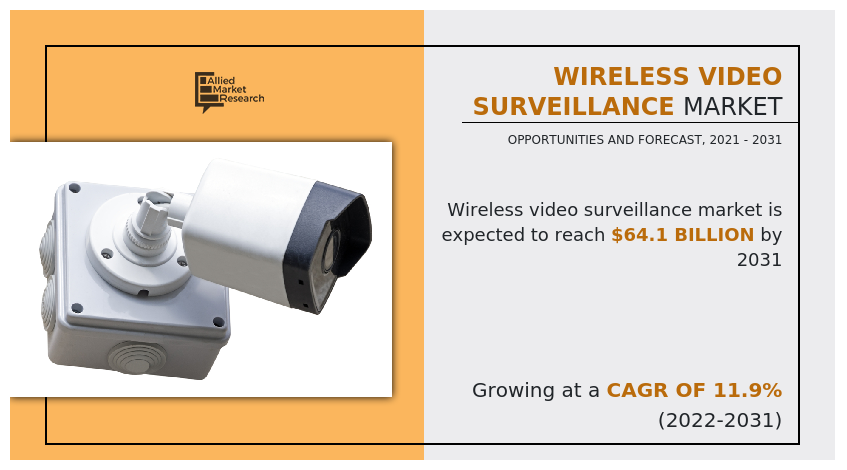
On account of the increase in the adoption of advanced surveillance by the government sector, manufacturers have realized the need for optimum wireless video surveillance systems. There are many advantages that an IP camera CCTV system offers over an analog format. IP security cameras send their signals over a network, allowing greater information transfer than an analog signal sent to a digital video recorder (DVR). Network cameras can be wireless and still work through a network and are used in big departmental stores, food chains, malls, factories, workshops, and other public places to keep a check of various activities. This factor is expected to significantly affect the wireless video surveillance market size.
The rise in the need for safety in high-risk areas, the surge in the transition from analog surveillance to IP cameras, and the integration of Internet-of-Things boost the growth of the wireless video surveillance industry. However, factors such as high investment costs and lack of professional expertise in handling IP cameras hamper the wireless video surveillance market growth. Furthermore, an increase in trends toward the development of smart cities is expected to offer lucrative wireless video surveillance market opportunities. Moreover, the demand for wireless home video surveillance is also on the rise across the globe.
The wireless video surveillance market is broadly segmented based on component, application, customer type, and region. By component, the market is bifurcated into hardware and services. The hardware segment is further divided into camera, storage device, and monitor. Furthermore, the storage device segment is bifurcated into hard disk drives, solid-state drives, removable flash memory cards, mini DVDs, and others. The services type segment is divided into video analytics, VSAAS, and integration services. By application, the market is divided into commercial, military & defense, infrastructure, residential, and others. By customer type, the market is segmented into business-to-business and business-to-customer.
Notable factors that positively affect the wireless video surveillance market share include a rise in the need for safety in high-risk areas, growth in the transition from analog to IP cameras, and integration of IoT in wireless surveillance cameras. However, high investments, such as initial installments and large data storage problems, with a ack of professional expertise in handling IP cameras incur extra costs for such devices. This factor is expected to hinder the market growth. Moreover, emerging trends toward the development of smart cities are expected to offer huge market opportunities in the coming years.
Segment Overview
The wireless video surveillance market is segmented into Components, Applications, and Customer Types.
By component, the market is bifurcated into hardware and services. The hardware segment was the highest revenue contributor to the market.
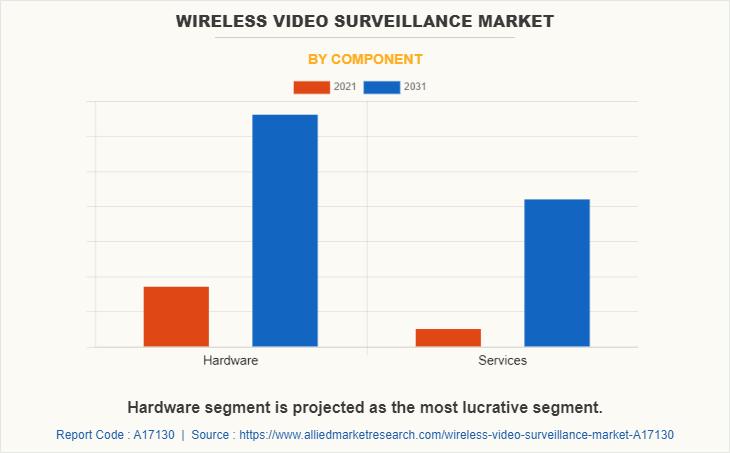
By application, the market is divided into commercial, military & defense, infrastructure, residential, and others. The commercial segment was the highest revenue contributor to the market.
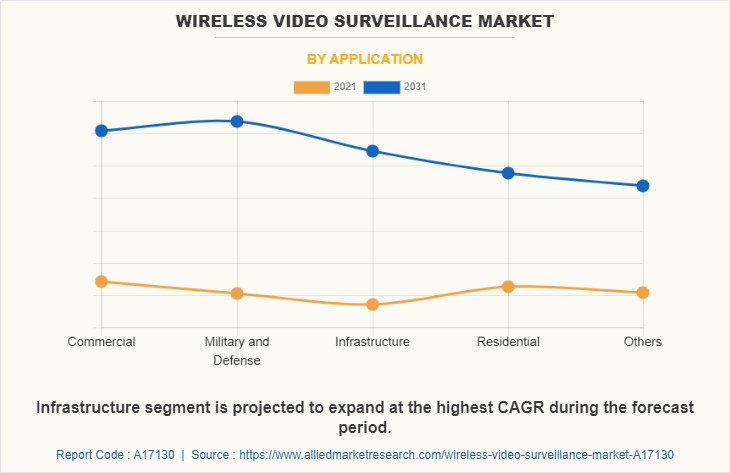
By customer type, the market is segmented into business-to-business and business-to-customer. The business-to-business segment was the highest revenue contributor to the market.
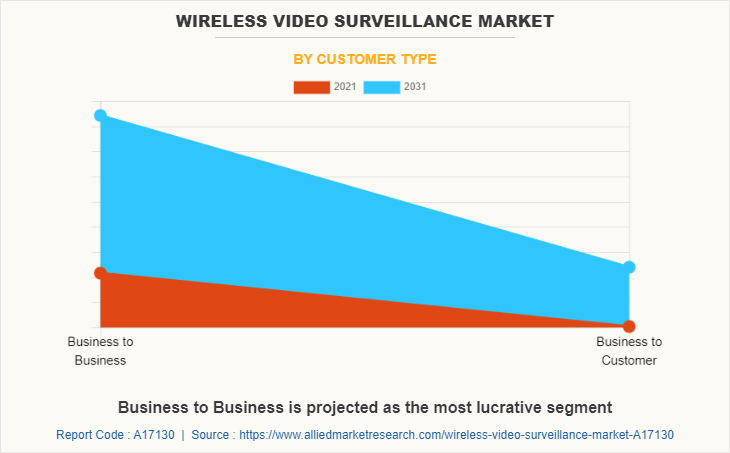
Region-wise, the wireless video surveillance market trends are analyzed across North America (the U.S., Canada, and Mexico), Europe (UK, Germany, France, Italy, Spain, Russia, Poland, and the rest of Europe), Asia-Pacific (China, Japan, India, South Korea, Philippines, Australia, Indonesia, and rest of Asia-Pacific), and LAMEA (Latin America, the Middle East, and Africa). North America, specifically the U.S., remains a significant participant in the global wireless video surveillance industry. Major organizations and government institutions in the country are intensely putting resources into the technology.
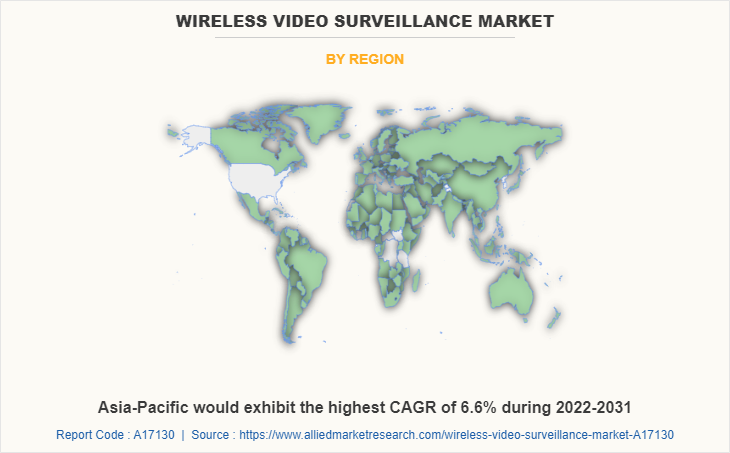
Competitive Analysis
The key players profiled in this report include Axis Communications AB, Bosch Security Systems Gmbh, Camcloud, Cisco Systems Inc., CP PLUS, Dahua Technology Co. Ltd., D-Link Corporation, Eagle Eye Networks, Flir Systems Inc., Genetec, Hangzhou Hikvision Digital Technology Co, Ltd., Honeywell Security, Ivideon, Panasonic Corporation, Pelco (Schneider Electric), The Infinova Group, and Verkada Inc. These key players have adopted strategies, such as product portfolio expansion, mergers & acquisitions, agreements, regional expansion, and collaborations to enhance their market penetration.
Key Benefits for Stakeholders
- This report provides a quantitative analysis of the market segments, current trends, estimations, and dynamics of the wireless video surveillance market analysis from 2021 to 2031 to identify the prevailing wireless video surveillance market opportunity.
- The market research is offered along with information related to key drivers, restraints, and opportunities.
- Porter's five forces analysis highlights the potency of buyers and suppliers to enable stakeholders to make profit-oriented business decisions and strengthen their supplier-buyer network.
- An in-depth analysis of the wireless video surveillance market outlook assists in determining the prevailing market opportunities.
- Major countries in each region are mapped according to their revenue contribution to the global market.
- Market player positioning facilitates benchmarking and provides a clear understanding of the present position of the market players.
- The report includes an analysis of the regional as well as global wireless video surveillance market trends, key players, market segments, application areas, wireless video surveillance market forecast, and market growth strategies.
Wireless Video Surveillance Market Report Highlights
| Aspects | Details |
| By Component |
|
| By Application |
|
| By Customer Type |
|
| By Region |
|
| Key Market Players | Cisco Systems, Inc., Camcloud, Bosch Security Systems Gmbh, Eagle Eye Networks, Inc., D-Link Corporation, Dahua Technology Co,. Ltd, Pelco (Schneider Electric), Honeywell Security, FLIR Systems, Inc., Genetec, Axis Communications AB, Panasonic Corporation, Ivideon, CP PLUS, The Infinova Group, Verkada Inc., Hangzhou Hikvision Digital Technology Co., Ltd |
Analyst Review
The wireless video surveillance market is expected to leverage high potential for commercial and infrastructure industry verticals. The current business scenario is witnessing increase in demand for wireless video surveillance systems, particularly in developing regions, owing to increase in government mandates related to public safety and security. Companies in this industry are adopting various innovative techniques, such as mergers and acquisitions to strengthen their business position in the competitive matrix.
The wireless video surveillance market is steadily gaining traction, owing to rise in demand for enhanced technologies in surveillance systems such as integration of IoT, AI, and rise in adoption of IP cameras over analog cameras for surveillance and monitoring. A shift from analog to IP technologies, cloud solutions for storage, and rise of video surveillance-as-a-service (VSaaS) present new, untapped opportunities for security solution providers.
Smart city projects have created a huge demand for the video surveillance. In addition, new technologies are being integrated to provide functioning of the monitoring system with introduction of special solar-powered cameras in remote locations. Thus, all these factors create lucrative opportunities for the market growth.
The key players profiled in the report include, Axis Communications AB, Bosch Security Systems GmbH, Camcloud, Cisco Systems Inc., CP PLUS, Dahua Technology Co. Ltd., D-Link Corporation, Eagle Eye Networks, Flir Systems Inc., Genetec, Hangzhou Hikvision Digital Technology Co, Ltd., Honeywell Security, Ivideon, Panasonic Corporation, Pelco (Schneider Electric), The Infinova Group, and Verkada Inc.
Commercial uses is considered to be he leading application of Wireless Video Surveillance Market.
The largest regional market for Wireless Video Surveillance Market is expected to be North America region.
The global wireless video surveillance market size was valued at $20,984.6 million in 2021.
The major players in the Wireless Video Surveillance Market are Axis Communications AB, Bosch Security Systems Gmbh, Camcloud, Cisco Systems Inc., CP PLUS, Dahua Technology Co. Ltd. and others.
By Component, the hardware segment is expected to grow at the highest CAGR during the forecast period.
Loading Table Of Content...


